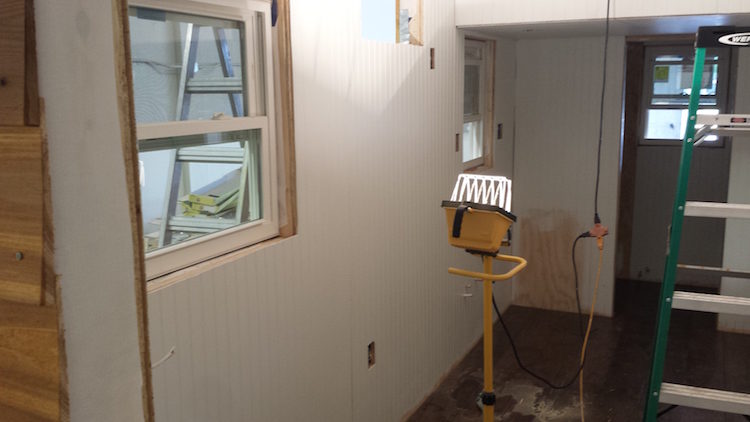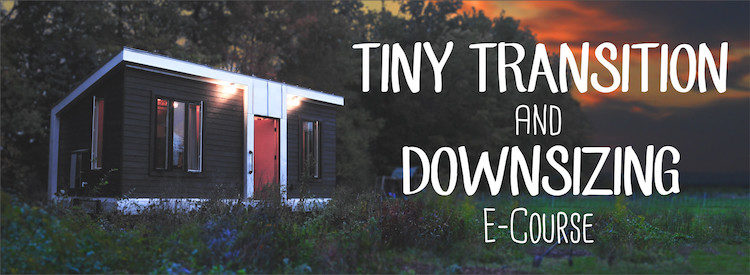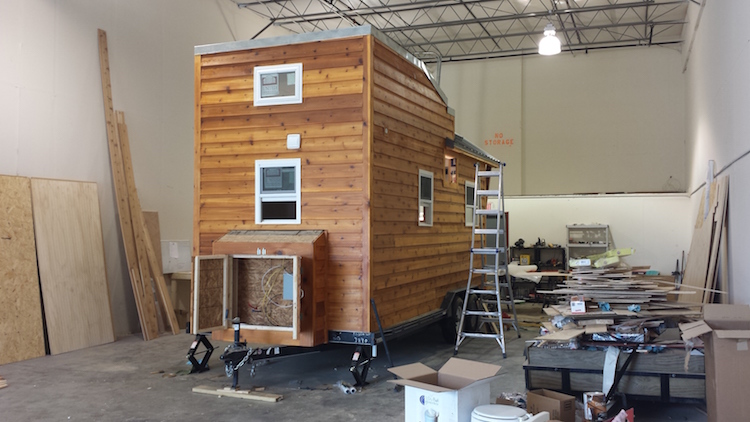The nest session of the Tiny Transition and Downsizing E-Course starts on June 28th, and I’d love to see you in there! This is an 8-week course that fundamentally changes your relationship with stuff and helps you de-clutter, downsize, and clear out your home and mind, in a step-by-step zero-overwhelm environment.Registration is open for the session beginning on June 28th. Preparing to transition into a tiny home, RV, trailer or cabin? Just want to clear your space and get some sanity in your current home? This is for you. You’ll be in supportive group of like minded friends and kindred spirits! Register here and join us for the next session.
I’ll let Jenn take it from here!
Downsizing is no easy task. We all have become so accustomed to having so muchstuff, that we don’t even realize how much we’ve acquired over time until we are forced to a) move it or b) take an objective look at it.
When I decided to build a tiny house, I knew I had some downsizing to do. I had, after all, filled a mid-sized U-Haul truck all by myself the last time I moved. Like most people, I had a bedroom full of furniture, a dining set, living room furniture, a second bedroom set in the guest bedroom, several Rubbermaid bins full of keepsakes, kitchen appliances, luggage, sporting equipment and on and on it went.
But I was still surprised at just how much I had when I had to think of it in terms of 144 square feet.
Downsizing your belongings, whether you just want to lighten up a little or get rid of 90% of your stuff (like I did), should be done in small steps, like we do in the Tiny Transition and Downsizing class. Trying to do everything all at once can be overwhelming at best and paralyzing at worst. By breaking up the task into smaller chunks, it will seem less impossible.
And since your house is already divided into rooms, you’ve got a game plan already set for you! Take each room one at a time, tackling the belongings in each one before moving on to the next. Don’t rush, take your time and be gracious with yourself. Getting rid of your belongings can be very challenging, especially if they hold sentimental or emotional value.
The key is to be realistic.
- Don’t hold on to something because you might use/need it.
- Don’t hold on to something because you want to use it one day.
Don’t hold on to something because you used to use/need it.
Be honest. Think about whether you really use or need something on a daily basis. If you don’t, get rid of it. Believe me, you’ll be glad you did!
If you hesitate at the idea of dropping all of your unwanted stuff off at Goodwill… there are lots of other options! You can sell items on Craigslist or eBay, give them to friends or family members or donate them to homeless or abused women’s shelters.
Just get rid of it.
Now… on to the good stuff!
Here are some tips for getting through each room of your house. Remember, these are just suggestions. Only you know what will work best for you. But be honest and be brave! Free yourself from your stuff!
Kitchen
The kitchen can be a breeding ground for junk. With a plethora of gadgets and gizmos available for every single task, it’s easy to find your drawers and cabinets overflowing with things you don’t use. But when it comes down to it, how many of these do you really need?
First, get rid of all the single-use appliances that only do one thing. This can include things like:
- Ice cream maker
- Popcorn popper
- Yogurt machine
- Waffle iron
- Rice cooker
- Bread machine
Then, get rid of all your duplicates. You don’t need two colanders, two crock pots, five spatulas, three pairs of tongs and three pitchers. You need ONE of each one of these. Yes, even the spatulas. If it gets dirty and you need to use it again, that’s what soap and water are for.
And that goes for appliances too. You don’t need to have a coffee grinder, a coffee maker, a cappuccino maker and a Keurig unless you run a coffee shop out of your kitchen. You need one machine that makes coffee. Pick your favorite one and get rid of the others. (We go into how to downsize your kitchen in detail in the Tiny Transition & Downsizing course, you should join us!)
Living Room
In the living room, we tend to accumulate things like music, books, DVD’s and video games. They are all great forms of entertainment and are each okay in their own right. But if not careful, they can grow like weeds.
Go through each book, each movie, each CD, each DVD/Blu-Ray disc and each video game. IF you keep them, only keep the ones that you really use or watch regularly. Not the ones that you might watch or watch once in a while.
An even better option is to go digital. Purchase the movies you want on iTunes or watch them on Netflix or Hulu. Buy digital copies of your favorite books on a Kindle or the Kindle app for your phone. And download your favorite video games onto your computer or gaming system. (In the Tiny Transition e-course, there is an entire lesson devoted to digitizing your media in the simplest, most effective ways).
You can still have all of your favorite forms of entertainment without all the bulk.
Bathroom – The bathroom is another breeding ground for unused stuff. How does that cabinet under the sink get so full anyway? Some things you can get rid of right off the bat:
- Expired OTC and prescription medications
- Half-full bottles of shampoo, conditioner, shower gel, etc.
- Expired sunscreen or bug spray
- Hardened bottles of nail polish
- Old make-up products and brushes
- Medicines or vitamins you no longer need or take
If you have products like shampoo, conditioner, shower gel, shave cream or cosmetic items that are still good and/or are unopened, donate them to those that need them like a homeless or domestic abuse shelter.
You should also get rid of small appliances that you don’t use regularly like hot rollers, straightening irons, steamers or water piks. If you don’t use them every day, they are just taking up space and you don’t need to keep them.

Bedroom – The biggest thing to downsize in most of our bedrooms is the closet. It has been said that most people only wear 20% of their wardrobe and when you set out to downsize your closet, you will find this to be true. (If you don’t believe me, pay attention next time you do your laundry – it’s the same items every week!)
Some things to get rid of here:
- Clothes that are too small or too big for you
- Clothes that have holes or stains
- Shoes that have holes or are falling apart
- Clothes that you haven’t worn in the last six months (or last year if they’re out of season)
- Clothes that can only be worn for a single purpose
- Duplicate items
Again, the key is to be honest with yourself. Don’t get caught up in being nostalgic or starting to think “Oh, I might wear that!” If you don’t wear it on a regular basis, get rid of it.
The rest of the house – There will be lots more rooms to go through and lots more stuff to downsize, but this will get you off to a great start. And remember, the same rules apply to every decision you make.
Do I really need this?
Do I really use this?
Can I live without it?
So go get to it! You’ll feel lighter which each decision you make. Happy downsizing!


Great article. You briefly mention where things that don’t make the cut might go, and I’d put even more emphasis on this. Some things are ideal donations: generic clothing in good shape, small working appliances, picture frames, etc. Other things (collectables, designer handbags, fine china, newish furniture, etc) can be sold at auction, in consignment shops, on eBay and half.com, through Craigslist and at yard sales. Once I fixed in my head that every dollar I made on something going out the door was another dollar for my tiny house build, it made the decision process easier.
This comment does not apply only to this post but I chose this opportunity to expose my point of view. I’ve been following tiny house blogs for years and living tiny for many more years. I’ve found many great ideas on these blogs but always felt we didn’t share the same spirit. Are we talking about living tiny or “fancy RVing”?
I find there are two categories of people living tiny. Most blogs talk about middle class people building fancy RVs to travel around. Those are the ones who will downsize by throwing away good stuff, knowing they can always buy more when needed.
You must nevertheless acknowledge that most people living tiny around the world do it for financial reasons. If I have extra shampoo, I will end up using it; If I have clothes with holes or stains, I will use them for gardening or mechanics, avoiding damaging my “good” clothing.
I have a good job but I live in an expensive area (French Riviera). I could rent a place and eat pasta all year. If I save on housing, I can live fine and still afford eating out with friends.
My tiny house has no wheels and cost me 2000 USD to build (salvaged and NOS materials). If I have usable stuff, by no means will I throw them away. I will just store them and use them when needed.
It’s a shame tiny living is spoiled by rich organic neo-hippies. I share the environmental issues ( I work in sustainable environment management) , but am not in the fancy RV movement.
Again, don’t take this personal, I posted here but actually wanted to react to the general feeling promoted in this blog. Just keep up with the good ideas, useful to both the rich and poor.
Thank you, Guillaume! I have often found this strange advice. Why would I throw away perfectly good shampoo? At some point, every shampoo bottle will have less than half in it. Are we to throw it out once it reaches that point? I have those shampoo bottles, and instead of buying new shampoo, I’m working through what I have. But by all means donate, for a quick fix.
And if you regularly use 2 spatulas when you’re cooking, obviously you need 2 – you can’t keep washing them in the middle of cooking!
And duplicate clothes are great. If you wear similar outfits all the time, and stick to a limited palette, of course you’ll want duplicates. I have several black tops and black trousers, several green shirts, 3 green skirts, several very similar cool summer dresses. If you wear a different style every day, well, maybe.
I think there are some good suggestions here, but we do have to adapt them to our own needs.
I’ve found a rice cooker and a crock pot are essential in a small kitchen. If it can be cooked in a pot it can be cooked in a rice cooker. (At least the type I own)
Plus in a hot environment like Florida where I live you do Not want to have anyanything that makes a lot of heat in the summer. My rice cooker made less waste heat than my stove top. I believe it used less power too as it shut itself off once your food was done cooking.
Thanks for helping me decide that my instapot needs to come with me to the tiny house. It is both a rice cooker and a crock pot and more. It felt indulgent, but throwing it out is indulgent.
I’d rather just start with a list of what I do use and then discard the rest.
Fussing over each item is stressful and time-consuming.
Prior to building, examine a new lifestyle:
Try one set of stackable kitchenware and one-pot recipes. Try using one kitchen sink and a portable stovetop.
Sleep in a hammock or on a roll-up floor mat. Try floor cushions.
Recombine a minimal amount of clothes for the most outfits.
Go paperless. Use a handheld computer for all media.
Once you have determined your most comfortable degree of minimalism, then calculate square footage.
Begin with a list of the most minimal. A one-week wardrobe, one set of kitchenware/linens and a daybed may be all that is needed.
Anything more requires greater square footage, maintenance and repair.